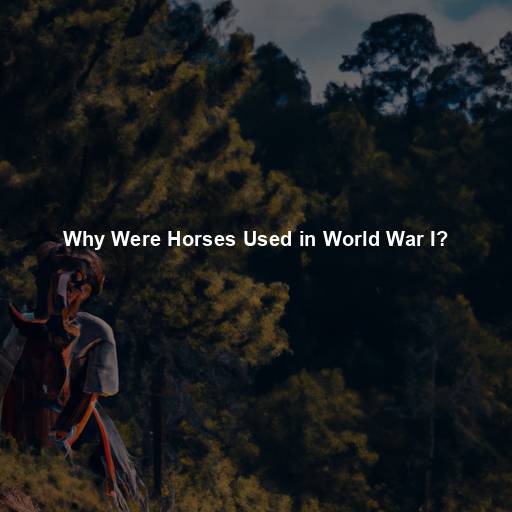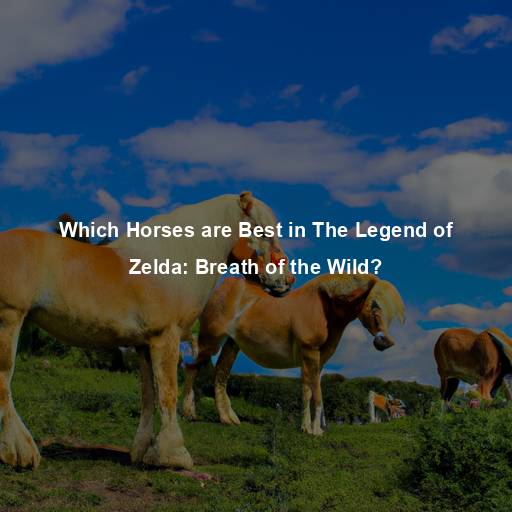Why Were Horses Used in World War I?
Last Updated on October 30, 2023 by Evan
Contents
- 1 The Role of Horses in World War I
- 2 The Legacy of Horses in World War I
- 3 The Impact of Horses on Soldiers and Society
- 3.1 The Bond Between Soldiers and Horses
- 3.2 Horses in Popular Culture and Art
- 3.3 The Legacy of Horses in World War I
- 3.4 Post-War Changes in Military Strategies
- 3.5 The Demise of Cavalry Units
- 3.6 The Transition to Motorized Vehicles
- 3.7 Remembering the Horses’ Sacrifice
- 3.8 The Ethical Debate
- 3.9 Lessons for Future Conflicts
- 3.10 The Enduring Bond Between Humans and Horses
- 4 FAQs – Why Were Horses Used in WW1?
The Role of Horses in World War I
Horses have been invaluable companions to humans for centuries, serving various purposes from transportation to labor. However, their role in warfare became particularly significant during World War I. In an era dominated by mechanization and technological advancements, it may seem puzzling that horses still played a vital role on the battlefield. This essay aims to delve into the reasons behind the utilization of horses during World War I and shed light on their immense contributions.
Transportation and Mobility
One of the primary reasons horses were utilized in World War I was their unparalleled transportation and mobility capabilities. In an era before the widespread use of motorized vehicles, horses provided a reliable means of transportation across different terrains, including the muddy and treacherous conditions of the Western Front. Horses were used to transport troops, supplies, and artillery, allowing for rapid mobility and flexibility on the battlefield.
Cavalry Charges and Shock Tactics
The shimmering spectacle of cavalry charges, once deemed invincible strategies, maintained their allure at the dawn of World War I. These brave soldiers, adorned with rifles, pistols, and gleaming sabers, sought to cleave through enemy ranks and sow chaos in the heart of battle. The gallant steeds, with their thundering hooves and unwavering might, propelled these daring maneuvers, rendering them indispensable in the pursuit of offensive triumph. Yet, as time waltzed forward and the ghastly tableau of trench warfare unfolded, the potency of cavalry charges waned, leaving perplexity and bewilderment in their wake.
Artillery Support and Logistics
During the tumultuous era of World War I, the unsung heroes known as horses emerged as an unexpected backbone, bolstering the mighty artillery operations. These gallant creatures were entrusted with the weighty task of hauling formidable artillery pieces and vital ammunition, tirelessly navigating treacherous terrains to ensure the unyielding flow of firepower to the frontlines. The absence of equine companions would have undoubtedly thrust artillery units into disarray, as the nascent motorized vehicles of the time lacked the prowess to conquer the formidable battleground landscapes.
Communication and Messenger Duties
In an era before the widespread use of wireless communication, horses served as vital messengers on the battlefield. They were used to relay messages between different units, headquarters, and commanders. Horses proved to be reliable and swift messengers, ensuring that critical information reached its intended recipients in a timely manner. This was particularly crucial in the fast-paced and rapidly changing environment of warfare.
Unaffected by Gas Attacks
One fascinating aspect that set horses apart from soldiers during World War I was their surprising resilience to the abhorrent aftermath of gas attacks. In this dreadful era of chemical warfare, where lethal gases like chlorine and mustard gas were unleashed, soldiers relied on gas masks for their survival. However, horses, in an astonishing twist of fate, seemed to possess an innate immunity, remaining mostly unscathed by the pernicious effects of these gas assaults. This rare attribute allowed these remarkable creatures to persistently fulfill their duties even amidst the bewildering chaos of a gas attack.
Psychological Impact
Horses also had a significant psychological impact on the soldiers fighting in World War I. The presence of horses on the battlefield brought a sense of familiarity and comfort amidst the chaos and destruction. Soldiers found solace in their equine companions, forming strong bonds with them and finding respite from the horrors of war. Horses provided a source of emotional support and companionship, boosting the morale of the troops.
Limited Technological Advancements
Although the early 20th century witnessed rapid technological advancements, the utilization of motorized vehicles in warfare was still in its infancy during World War I. The unreliability and limited capabilities of early motorized vehicles, coupled with the challenging terrain and logistical constraints of the battlefields, made horses a more viable option for many military operations. It was not until later in the war that motorized vehicles began to replace horses in certain roles.
Tradition and Symbolism
Lastly, the use of horses in World War I was also influenced by tradition and symbolism. Horses had long been associated with warfare and heroism throughout history, and their presence on the battlefield carried a symbolic weight. The sight of mounted cavalry charging forward evoked notions of bravery, honor, and chivalry. Furthermore, horses held a revered place in military traditions, and their continued use during World War I upheld these traditions and maintained a connection to the past.
The Legacy of Horses in World War I
When contemplating the impact of World War I, it’s impossible to overlook the enigmatic role horses played in this extraordinary chapter of history. The depths of their involvement were both awe-inspiring and heart-wrenching, as their valiant efforts were not without dire consequences. Millions of these majestic creatures succumbed to the unforgiving chaos of war, forever altering the landscape of battle. As technology surged forward, relegating them to the annals of military nostalgia, a profound era came to an end.
In conclusion, horses were used in World War I due to their unmatched transportation capabilities, their role in cavalry charges and shock tactics, their support in artillery operations, their use as messengers, their immunity to gas attacks, their psychological impact on soldiers, the limited technological advancements of the time, and the traditions and symbolism associated with their presence. The legacy of horses in World War I serves as a testament to their unwavering loyalty, bravery, and the remarkable bond between humans and animals. ## The Evolution of Warfare and the Role of Horses
The Shift Towards Mechanization
As World War I progressed, the introduction of more advanced technologies and the increasing prevalence of mechanized warfare gradually diminished the role of horses on the battlefield. The development of tanks, armored vehicles, and improved motorized transport led to a shift in military tactics and strategies. These technological advancements offered greater speed, firepower, and protection than horses could provide.
The Rise of Motorized Vehicles
The advent of motorized vehicles signaled a transformative shift in the transportation landscape. Gone were the days of relying solely on horses to navigate rugged terrain and transport goods. Instead, trucks and motorcycles burst into the scene, boasting the ability to handle challenging logistics with a perplexing efficiency. And with the march of technological progress, even the once integral role of horses as messengers began to fade, as the ubiquitous presence of wireless communication took its place.
The Decline of Cavalry Charges
When trench warfare became the new norm and the power of modern weaponry took center stage, the traditional might of cavalry charges had little chance of success. The intricate web of trenches and formidable barbed wire barriers, coupled with the sheer destructive force of machine guns and artillery, created a battlefield perplexity that mounted troops struggled to navigate. As the nature of warfare evolved, the futility of cavalry charges became glaringly evident, transforming them into relics of a bygone era.
Specialized Roles for Horses
Although their prominence on the battlefield diminished, horses still had some specialized roles during World War I. They were utilized by reconnaissance units, where their speed and agility allowed for quick scouting missions. Additionally, horses found use in mountainous terrains and other areas where motorized vehicles were impractical. In these specific contexts, horses continued to play a valuable role in supporting military operations.
The Impact of Horses on Soldiers and Society
The Bond Between Soldiers and Horses
The relationship between soldiers and horses during World War I extended beyond their utilitarian roles. Horses provided companionship, solace, and a sense of normalcy amidst the chaos of war. Many soldiers developed strong emotional bonds with their horses, relying on them not only for practical purposes but also for emotional support. The loss of a trusted horse could be deeply felt by soldiers, further emphasizing the profound connection that developed between them.
Horses in Popular Culture and Art
The indelible imprint of horses during World War I transcended mere historical accounts, seeping deeply into the veins of artistic expression. Heartfelt poems, gripping novels, and vivid paintings sprung forth, each a testament to the valor and sacrifice unleashed by these majestic creatures on the unforgiving battlefields. These thoughtful embodiments wove a tapestry of remembrance, etching the memory of these noble beings into the collective consciousness. An emblem of dauntless courage, unwavering loyalty, and the profound toll exacted by a world steeped in agonizing chaos, horses became icons of the harrowing human experience.
The Legacy of Horses in World War I
The legacy of horses in World War I extends beyond their tangible contributions on the battlefield. Their service and sacrifice left an indelible mark on the collective memory of nations involved in the conflict. Monuments and memorials dedicated to the horses of World War I can still be found in various countries, serving as a testament to their enduring significance.
Post-War Changes in Military Strategies
In the wake of the tumultuous World War I, the battlefield had something strikingly puzzling in store: a transformation of gargantuan proportions in the realm of equine warfare. As the echoes of conflict gradually subsided, nations found themselves standing at the precipice of change, poised to embrace the perplexing notion of adapting their military strategies to the shifting sands of time. The war had sown the seeds of realization, exposing the glaring limitations in relying solely on our noble equine companions amidst the chaos of modern warfare, urging us to burst forth into a new era of mechanization and unfathomable military technologies.
The Demise of Cavalry Units
In the wake of the tumultuous aftermath of the Great War, the dwindling significance of cavalry units cowered under the weight of a new reality. The harrowing lessons harvested from the trenches and cutting-edge firepower unveiled the futility of the once-glorious tactic of charging valiantly on horseback. Nations, gripped by the grip of perplexity, made the grave decision to disband their traditionally revered cavalry units or reshape them to fulfill alternative roles. The era of mounted warriors galloping into the smoke of battle had faded into the annals of history, replaced by a bewildering new paradigm.
The Transition to Motorized Vehicles
The use of motorized vehicles continued to expand in the aftermath of World War I. Trucks, armored cars, and motorcycles became the preferred mode of transportation for troops and supplies. The increased mobility, speed, and carrying capacity of motorized vehicles made them far more efficient and practical than horses. The shift towards motorization further diminished the role of horses on the battlefield.
Remembering the Horses’ Sacrifice
Despite their diminished role, the contributions and sacrifices of horses during World War I should never be forgotten. These noble creatures played a crucial part in supporting soldiers and ensuring the smooth functioning of military operations. Their loyalty, courage, and unwavering service deserve recognition and remembrance. Monuments and memorials dedicated to the war horses stand as a solemn reminder of their invaluable contributions.
The Ethical Debate
Throughout the annals of history, the contentious issue of animals’ role in warfare has ignited fiery ethical discussions, and the First World War proved no different. Detractors contend that employing horses in battle thrust them into a vast abyss of needless agony and peril. The grim toll of casualties among these loyal equine warriors stands as a haunting testament to the harrowing dangers they confronted on the battlefield. This ongoing debate compels us to ponder our solemn duty towards animals and wrestle with the intricate ethical ramifications entwined within their participation in warfare.
Lessons for Future Conflicts
History is a curious guide, whispering tales of forgotten battles and their surprising lessons. In the tumultuous dance of war, horses once raced across battlefields, their hooves echoing a timeless rhythm of tradition and innovation. The echoes of World War I reveal the delicate balance between honoring the past and embracing the future, as military strategies evolved alongside the relentless march of technology. As the dust settled, these lessons carved the path towards mechanized warfare, propelling the rise of armored vehicles and a new era of military might.
The Enduring Bond Between Humans and Horses
The undeniable connection between humans and horses withstands the test of time, despite the decline of horses in warfare. These majestic creatures have seamlessly transitioned into avenues such as sports, recreation, therapy, and companionship, leaving an indelible mark on human life. Their enduring presence and the profound bond they create serve as a captivating testament to the resilience and captivating power of this remarkable relationship.
FAQs – Why Were Horses Used in WW1?
What role did horses play in World War 1?
In the grand theater of World War 1, horses asserted their significance, standing steadfast amidst the chaos and carnage. These noble creatures gallantly bore the weight of a nation’s hopes on their sinewy backs, transcending mere beasts of burden. With unwavering determination, they traversed treacherous landscapes, lighting the path for soldiers and supplies, defying the very essence of terrain itself. Their gallant hooves echoed through the annals of history, capturing the hearts of warriors and embodying the essence of valiance in their very existence.
Why were horses preferred over other forms of transportation in WW1?
In the tumultuous era of World War 1, a peculiar preference emerged – the trusty steed. Amidst a landscape riddled with uncertainties, it seemed that horses held an inexplicable allure over other modes of conveyance. The nascent technological advancements faltered, unable to match the demands of war, leaving the domain of transportation to be adorned by the graceful yet enigmatic equines. With a flair for maneuvering through the treacherous labyrinth of trenches and forests, these four-legged companions became the embodiment of agility and adaptability on the battlefield. Their resilience, steadfast in the face of mechanical foibles and fuel scarcities, rendered them a resolute and reliable choice for the war-weary troops.
How many horses were used in WW1?
It is estimated that millions of horses were used in World War 1. Different countries involved in the conflict heavily relied on horses for logistical support and in combat. For example, the British Army alone sent around 1 million horses to the Western Front during the war. The exact number is difficult to determine due to the vast scale of the conflict and the varied contributions of each nation involved.
Were horses used in WW1 artillery units?
In the tumultuous battlegrounds of World War 1, a surprising and awe-inspiring force emerged – the mighty horses. With muscles rippling beneath their sleek coats, these majestic creatures harnessed their strength to the urgent demands of artillery units. Their hooves pounded the earth, propelling cannons, heavy artillery pieces, and wagons laden with ammunition towards the front lines. As the fog of war enveloped the land, these steadfast companions braved treacherous terrain, navigating with a resolute determination, ensuring that the firepower of the troops never waned. Their role was paramount, enabling soldiers to adapt swiftly amidst the chaotic dance of battle.
Did horses suffer casualties in WW1?
Unfortunately, horses were not immune to the horrors of war and suffered significant casualties during World War 1. They faced the same dangers as soldiers, being exposed to gunfire, artillery, and chemical attacks. Many horses were wounded, killed, or had to be euthanized due to injuries sustained on the battlefield. The harsh conditions, lack of proper care, and strenuous work resulted in high mortality rates for these animals. Their sacrifices and contributions should not be overlooked when reflecting on the human cost of the war.
Did the use of horses change after WW1?
The tides of war turned, and horses found themselves on an unraveling journey after the end of World War 1. The dazzling influx of roaring motorized marvels, especially the formidable tanks, shattered the once unbreakable bond between horses and warfare. In a turbulent twist, the galloping heroes became mere relics, drifting further away from the realm of modern warfare’s cold embrace. Despite their dwindling prominence, these noble creatures clung on, their hooves still clinging to specialized niches, like the regal ceremonies and the resolute mounted cavalry units. Yet, the grand narrative unquestionably witnessed the fading of their once-glorious contribution, and the winds of change whispered uncertainty into their manes.






